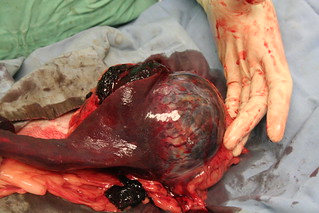(The names involved have been changed to protect identities, the medical details have not been changed.)
If you only remember one idea after reading this post, make sure it is this: performing a thorough physical examination and establishing a minimum database is of utmost importance.
It starts with a patient of ours, Nanook, a senior Husky, who is owned by a fantastic family, the Bartletts. We’ve managed hot spots here and there over the course of Nanook’s life, and most recently, we’ve been managing arthritis. Nanook is a sore fellow when he’s not on his anti-inflammatories, but with them he’s a comfortable, social, friendly Husky.
Not that long ago, while speaking with with one of the Bartlett’s grown kids, a new concern was raised. Nanook recently began dribbling urine, and he’s been waking up amidst a puddle of urine in his bed. A number of potential problems came to mind, from urinary tract infection to bladder stones to urinary incontinence to cancer of the urinary tract. It may be tempting for some to want to treat cases such as Nanook’s according to the symptoms, but I told the junior Bartlett that in order to have a better idea of what was going on, I’d need to see him. They scheduled an appointment for later that same day.
When Nanook presented, he was reluctant to stand… he’d shown this in the past with arthritis flare-ups. As I felt his belly, it was clear that his bladder was very, very full… we’ll see this when male dogs are experiencing obstruction of the urinary tract. In addition to his large bladder, I also felt a large mass toward the front of his belly. This was new. It didn’t fit with the symptoms that Nanook had shown in the past, and at first glance it didn’t fit with the symptoms that were described to me earlier in the day. Along with the mass, Nanook’s gums were a sort of pale-pink… a healthy Husky’s gums ought to be pink. It was around this point in the examination that another of the Bartletts told me that there had been some other times in the past couple of weeks where Nanook was unable to rise and stand.
Based upon my findings, I recommended that we gather some blood from Nanook and get some radiographs (x-rays) of his belly. This was what we found.
 The bladder, circled in orange, was significantly larger than one ought to be, and this was concerning. But what was more concerning was the large mass, circled in yellow here. Ultrasounding the mass confirmed that it was an enlarged spleen. Not knowing whether it was a malignant cancer or a benign mass of blood, we reviewed the surgical options and Mr. Bartlett bravely chose to pursue surgery. This was what we found.
The bladder, circled in orange, was significantly larger than one ought to be, and this was concerning. But what was more concerning was the large mass, circled in yellow here. Ultrasounding the mass confirmed that it was an enlarged spleen. Not knowing whether it was a malignant cancer or a benign mass of blood, we reviewed the surgical options and Mr. Bartlett bravely chose to pursue surgery. This was what we found.
|
The darker purple/black areas are where the mass had been bleeding into Nanook’s belly and robbing him of needed blood (and therefore oxygen and energy). This is why he was reluctant/unable to get up at various times over the past few weeks.
It’s hard to get a feeling about splenic masses. They’re usually ugly in appearance, but sometimes they’re benign (not an ugly cancer at the cellular level) and other times they’re malignant (an ugly cancer at the cellular level, one that has probably already spread somewhere else and will lead to death in the very short-term). Distinguishing them based upon outward appearance is very difficult, and if malignancy is present, determining which type is impossible based upon outward appearance.
Getting back to the case at hand, Nanook’s demeanor changed rapidly. He was much more active the day following surgery. A couple of days later I received the pathology report: a benign hematoma. Great news! And after I finished reviewing the report with Mr. Bartlett, he told me that Nanook’s urinary behavior had returned to normal. It’s amazing how much better a dog feels when he’s not bleeding into his belly!
In this post, we’ve talked about spleens and blood, bladders and urine, surgery and pathology reports. The take-home message, though, is this: had we simply treated Nanook without examining him, his tumor would have continued to bleed into his belly and at some point in time would have bled too much… he would have died as a result. The importance of the physical examination cannot be over-emphasized… it literally saved Nanook’s life.


